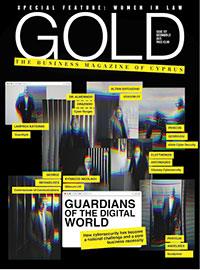Dr Mary Lynne Hedley, Sr Scientific Fellow, Broad Institute and Venture Partner, Third Rock Ventures, who was recently in Cyprus for an inspirational speech organised by Cyprus Seeds and The Cyprus Institute of Neurology & Genetics, explains why her decision to transition from the lab to the board room was her most important career decision.
Speaking to CBN, Dr Hedley describes what it was like to pivot from academia to entrepreneurship, noting: "We were very naive about business and drug development, but we learned".
Why did you visit Cyprus and what are your impressions?
We were invited to Cyprus by a colleague, Anna Protopapas, who is also one of the Cyprus Seeds Board members. She was kind enough to offer her home and hospitality and introduce us to the Cyprus Seeds organisation which is doing critically important work to ensure that the scientific advances and inventions of Cypriot scientists are translated into meaningful products. Cyprus Seeds selects and supports the best research teams with grants while offering mentoring opportunities and enabling networking with international entrepreneurs and organisations more broadly. I was so impressed by the enthusiasm and work of the young scientists we met and feel certain that working with Cyprus Seeds has been transformational to their experience and willingness to build an entrepreneurial ecosystem for the benefit of all Cypriots.
I also had a chance to explore a bit of the island and its history. Cyprus is a beautiful place, from the pristine waters to the sandy shores, limestone cliffs and cedar wood forests. The 7,000 years of history that defines the island has created a special ethos and culture of resilient people, fabulous food and welcoming hospitality. I am grateful to the organisation and to the many people who made my trip one to remember.
You’re speaking at an event designed to inspire academic researchers to commercialise their discoveries. From your experience, what are the key misconceptions academics have about entrepreneurship?
As entrepreneurs, we learn to share ideas in a way that inspires others to invest and join with us on the journey. The message and style are adapted to be effective with an audience that includes investors, patients, physicians, and are very different from those we use in scientific publications. We also grow to appreciate the time/value/money relationship. Investors are trusting us to reduce risk and increase value in a capital efficient manner. It is critical that we understand the risks associated with our ideas, work to mitigate them, remain goal focused and aligned with our investors on the definition of “value”. Generally speaking, this is very different from the exploratory approach and nature of basic research.
You’ve successfully transitioned from the lab to the boardroom. What was the pivotal moment when you first realised you wanted to become an entrepreneur rather than stay solely in academia?
During my training I had the opportunity to pursue an interest in international travel, remote mountain trekking and in providing health related assistance to others. These experiences highlighted for me the many ways education and research could be directed to improving human health and I was compelled to become a part of that effort. Two of my colleagues and I had an idea for a new type of medicine and decided to start a newco to pursue this approach. We were very naive about business and drug development, but we learned. It turned out to be my most important career decision.
Cyprus and the EU see only a sliver of academic research entering the market. In your experience as a senior fellow at the Broad Institute of MIT and Harvard, what are the best practices in translating academic research, and how can these be applied in Cyprus?
Particularly for product ideas that are capital intensive and have long development times it is critical to protect intellectual property (IP). Academic institutions in the US became efficient in licensing and spinning out newcos only after they created technology transfer offices to assist their researchers with this effort. For the academic researcher, to maintain the opportunity to patent an invention, it is critical to work with your technology transfer departments to file a patent application before submitting a manuscript for publication or presenting your data at a meeting.
At TESARO, you led not only scientific discovery but also commercialisation across two continents. What’s the most underestimated challenge in scaling a biotech company globally?
Capital efficiency, determining where to place your own resources and when to partner with others to extract the greatest value from your product portfolio is a critical strategic decision. At TESARO we commercialised in the US and EU, but we partnered with others to bring medicines to patients in the China and Japanese markets. The ramp to profitability in those regions was too long and expensive given the cost of our capital at that time.
Today, you're advising biotech CEOs and serving on the boards of major players like Eli Lilly and Veeva. What leadership traits do you find most lacking – and most essential – in first-time biotech CEOs?
First time CEOs coming out of an academic role are generally technical experts with little leadership and management training. They must quickly come to appreciate and become comfortable with how much they do not know about the business or science of making a medicine. The best leaders will be inspired to hire a team that complements their own personality and skill set and brings experience to the table. Confidence grows when you realise you do not need to be the expert to lead experts. At a minimum, leadership requires humility, a willingness to listen, learn, question, integrate and inspire. Especially today, effective leaders have the mental stamina and agility required to distil meaning from noise in the face of a rapidly changing environment.
Looking ahead to 2025 and beyond, how would you characterise the state of the biotech markets? What do you see as the most pressing challenges and the most overlooked opportunities?
The biotech market typically follows interest rates. As interest rates rise so too does the cost of capital and in such an environment, investors tend to prefer projects that can be de-risked early and with cost efficiency. Entrepreneurs respond by finding ways to sufficiently mitigate technical risks and by building a sufficient moat, or competitive advantage. This is a great time for biotech entrepreneurs and tech transfer offices to partner with big biotech or pharma as they are seeking to replenish their pipelines and are actively looking for new ideas. Their time horizons are longer and their risk tolerance can be significantly higher than that of many investors.
Finally, speaking of opportunities, artificial intelligence has become mainstream in biotech, accelerating drug discovery, design and clinical trial processes. So, where is AI making the biggest real-world impact today and where is the hype still outpacing the results?
AI is a fabulous tool and is used today to improve employee and enterprise efficiency in several operational areas including administrative functions and communications, the building of draft documents and presentations and signal seeking in enterprise risk management systems that monitor compliance and manufacturing. In the R&D space, a transformational leap was made with the introduction of alpha fold 3, an AI model with predictive capabilities for a broad spectrum of biomolecules that is helping us understand cells and biologic systems and is used routinely in drug discovery efforts. Cyprus’ own Demis Hassabis won the 2024 Nobel Prize in Chemistry for his work on this technology. Most emerging technologies confront early and appropriate scepticism, but over time many have advanced beyond the hype, the internet and social media are two examples, and I believe the use of AI to facilitate our understanding of biology and to ultimately design medicines will also fall into that category.









